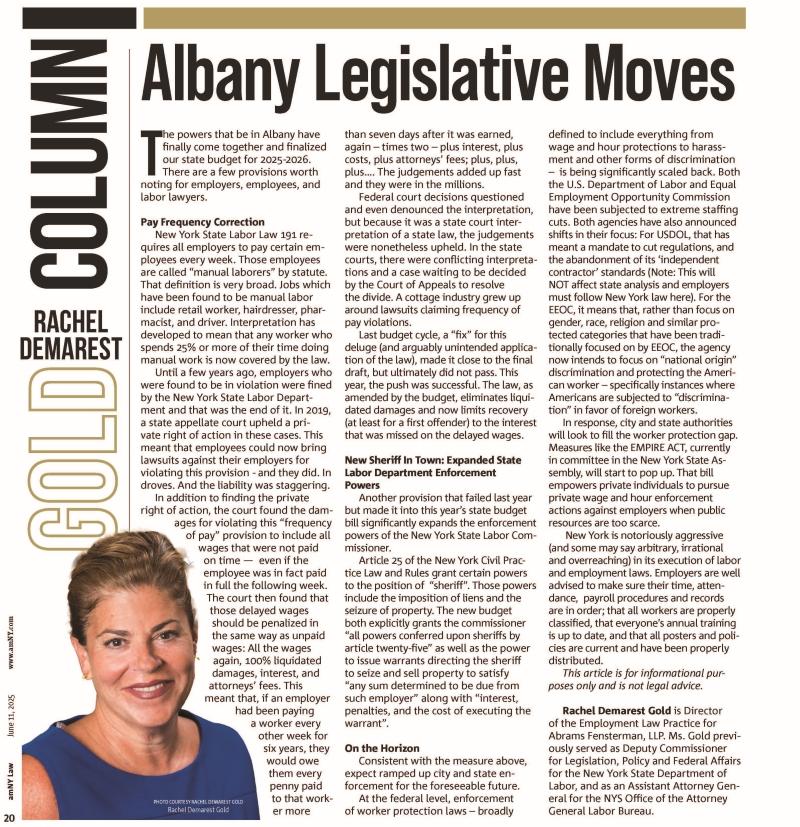Since 2007, New York employers have looked over their shoulders to see if the IRS or the state was knocking on their door to review the classification of employees. That is because in 2007, New York formed a Task Force to deal with the issue of worker misclassification, particularly improperly classifying an employee as an independent contractor. Since then, hundreds of businesses have faced audits and penalties because of misclassification. In addition, tighter rules have been enacted, including the New York Wage Theft Protection Act which effective February 1, 2012 will require employers to designate whether employees are exempt or nonexempt.
The issue in relation to misclassification as a contractor is whether the business has control over the means and the result of the work. If a business exercises sufficient control, then the worker is an employee rather than an independent contractor. In one recent case, the New York Court of Appeals held that an attorney who was a part time executive director of an organization was properly classified as an independent contractor despite the fact that he had minimal check writing authority. However, the New York State Labor Department has taken the position that the case is limited to where an attorney serves as part time executive director. Its other interpretations have increasingly favored a finding of employee status.
The Federal government has followed suit, announcing that it is committing additional funds to investigate and prosecute misclassification of workers. On September 21, 2011, the IRS announced that it would be offering a new program to businesses which would permit them to voluntarily reclassify workers as employees for federal employment tax purposes. The Voluntary Classifi cation Settlement Program (VCSP) permits eligible businesses to voluntarily reclassify for future tax periods with limited federal employment tax liability for previously treating the worker as an independent contractor. To participate, the business must meet eligibility standards, apply to participate, and enter into an agreement with the IRS.
To be eligible, the business must have consistently treated the workers as contractors, and must have fi led all required Forms 1099 for the workers for the previous three years. The business cannot currently be under audit by the IRS, or by the federal Department of Labor or any state agency. A previously audited business will only be eligible if the business has complied with the results of the audit.
The participating business will voluntarily agree to prospectively treat the class of workers as employees for tax purposes. In exchange, the business will pay only ten percent of the employment tax liability that may have been due on compensation paid to the workers for the most recent tax year, will not be liable for any interest and penalties on the liability and will not be subject to an employment tax audit concerning misclassification for prior years. However, the participating business must agree to extend the statute of limitations for the three calendar years after which the business signs the agreement to treat the workers as employees, thus lengthening the potential period of prosecution for future violations. Information about the program and applications will be available on www.irs.gov.
One note of caution: It is unclear whether the IRS will be sharing information about the reclassification with other agencies, and it is unclear how other agencies will treat it. For example, if the IRS shared information with the New York State Department of Labor without some concomitant New York State amnesty, it would be possible for New York State to come back against the business for unpaid unemployment taxes and workers compensation coverage, along with interest and penalties. Therefore, businesses should proceed cautiously if they choose to take advantage of this new program.
Another issue certain to arise in the near future is whether a business that misclassifies workers as contractors has additional liability for failure to complete the acknowledgment of wage form required for all employees as of February, 2012. Theoretically, in each situation in which an employer has improperly classified a worker as a contractor, the employer has also violated the requirement to obtain an acknowledgment of wage rate from the employee. Since the penalties are up to $2500 per employee, they can accumulate quickly.
As businesses attempt cost cutting in this difficult economy, they blur the distinction between exempt and non-exempt employees under both State and federal law. To be treated as exempt, most employees must: 1) perform duties deemed to be exempt (e.g., administrative, executive or professional), 2) be paid on a salaried basis, and 3) be paid the amounts required under State or Federal Law. Currently, most exempt employees must receive $455 per week to meet federal requirements, and $543.75 per week to meet New York State requirements. Issues arise when less than full day absences are deducted or employees are on furlough.
The conclusion from these issues is clear: All businesses have an incentive to correctly label workers as employees and to correctly determine their exempt status. Our advice to countless businesses has been to review these issues in advance, since much can be done to avoid a labor department finding of misclassification.
This was originally published by Rochester Business Alliance. Distribution or re-transmission without written consent of the copyright owner is prohibited.
To view the article in the Chamber Newsletter, click HERE.





